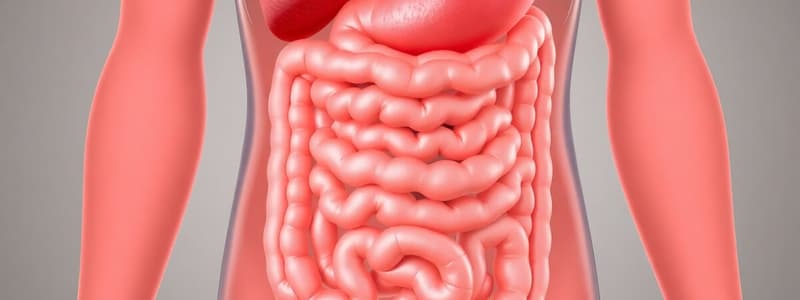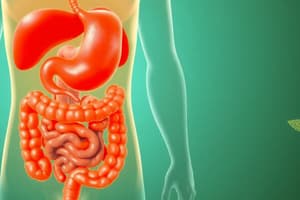Podcast
Questions and Answers
Describe the role of the hepatic portal vein in the assimilation process.
Describe the role of the hepatic portal vein in the assimilation process.
The hepatic portal vein carries blood rich in nutrients absorbed from the small intestine to the liver. This allows the liver to regulate the amount of nutrients entering the bloodstream and to process them further.
Explain the process of deamination and its significance in the assimilation of amino acids.
Explain the process of deamination and its significance in the assimilation of amino acids.
Deamination is the process of removing the amino group (-NH2) from excess amino acids. This converts them into ammonia, which is then converted into urea by the liver and excreted through urine. Deamination prevents the build-up of toxic ammonia in the body.
How does the liver act as a storage organ for nutrients?
How does the liver act as a storage organ for nutrients?
When excess glucose is present in the bloodstream, the liver converts it into glycogen and stores it. This stored glycogen can be later converted back into glucose when energy is needed by the body.
What are the two main functions of the large intestine in the digestive process?
What are the two main functions of the large intestine in the digestive process?
What are the specific substances absorbed by the large intestine?
What are the specific substances absorbed by the large intestine?
Explain the composition of faeces and how it is formed.
Explain the composition of faeces and how it is formed.
Describe the role of mucus in the movement of faeces through the large intestine.
Describe the role of mucus in the movement of faeces through the large intestine.
What triggers the need to defecate?
What triggers the need to defecate?
What role does water intake play in the health of the large intestine?
What role does water intake play in the health of the large intestine?
Identify two health issues related to poor eating habits and briefly describe one.
Identify two health issues related to poor eating habits and briefly describe one.
What can untreated gastritis lead to, and what are its primary causes?
What can untreated gastritis lead to, and what are its primary causes?
How does bulimia nervosa affect a person's physical health over time?
How does bulimia nervosa affect a person's physical health over time?
Describe muscle dysmorphia and its potential impact on an individual.
Describe muscle dysmorphia and its potential impact on an individual.
What is the process called when the rectum muscles contract to expel faeces?
What is the process called when the rectum muscles contract to expel faeces?
What are the seven food classes that make up a balanced diet?
What are the seven food classes that make up a balanced diet?
What unit is commonly used to measure the energy value of food?
What unit is commonly used to measure the energy value of food?
How does fibre contribute to the defaecation process?
How does fibre contribute to the defaecation process?
What are some short-term side effects of gastric bypass surgery?
What are some short-term side effects of gastric bypass surgery?
What health issues can arise from insufficient dietary fibre?
What health issues can arise from insufficient dietary fibre?
What is the role of vitamin C in fruits and vegetables?
What is the role of vitamin C in fruits and vegetables?
Why is obesity considered a health issue, and how can it be managed?
Why is obesity considered a health issue, and how can it be managed?
What are the main parts of the alimentary canal in the human digestive system?
What are the main parts of the alimentary canal in the human digestive system?
Distinguish between physical digestion and chemical digestion.
Distinguish between physical digestion and chemical digestion.
How does saliva contribute to the digestion of carbohydrates in the mouth?
How does saliva contribute to the digestion of carbohydrates in the mouth?
What adaptations does the ileum have for nutrient absorption?
What adaptations does the ileum have for nutrient absorption?
Describe the role of villi in nutrient absorption.
Describe the role of villi in nutrient absorption.
What enzyme is responsible for the breakdown of starch in the mouth, and what is its optimal pH range?
What enzyme is responsible for the breakdown of starch in the mouth, and what is its optimal pH range?
What is the function of lacteals in the villi?
What is the function of lacteals in the villi?
Explain the significance of microvilli in the villus structure.
Explain the significance of microvilli in the villus structure.
Flashcards
Digestion
Digestion
The process of breaking down large food molecules into smaller ones that can be absorbed by the body.
Physical Digestion
Physical Digestion
The mechanical breakdown of food into smaller pieces, like chewing and muscle contractions.
Chemical Digestion
Chemical Digestion
The chemical breakdown of large molecules into smaller ones using enzymes.
Salivary Amylase
Salivary Amylase
Signup and view all the flashcards
Ileum
Ileum
Signup and view all the flashcards
Villi (singular: Villus)
Villi (singular: Villus)
Signup and view all the flashcards
Epithelial Layer of the Villus
Epithelial Layer of the Villus
Signup and view all the flashcards
Microvillus
Microvillus
Signup and view all the flashcards
Assimilation
Assimilation
Signup and view all the flashcards
Hepatic Portal Vein
Hepatic Portal Vein
Signup and view all the flashcards
Lacteals
Lacteals
Signup and view all the flashcards
Thoracic Duct
Thoracic Duct
Signup and view all the flashcards
Deamination
Deamination
Signup and view all the flashcards
Large Intestine
Large Intestine
Signup and view all the flashcards
Faeces
Faeces
Signup and view all the flashcards
Defaecation
Defaecation
Signup and view all the flashcards
What is Gastritis?
What is Gastritis?
Signup and view all the flashcards
What is Anorexia Nervosa?
What is Anorexia Nervosa?
Signup and view all the flashcards
What is Bulimia Nervosa?
What is Bulimia Nervosa?
Signup and view all the flashcards
What is Muscle Dysmorphia?
What is Muscle Dysmorphia?
Signup and view all the flashcards
What are the risks of poor eating habits?
What are the risks of poor eating habits?
Signup and view all the flashcards
Balanced Diet
Balanced Diet
Signup and view all the flashcards
Energy Value of Food
Energy Value of Food
Signup and view all the flashcards
Calorie
Calorie
Signup and view all the flashcards
Gastric Bypass
Gastric Bypass
Signup and view all the flashcards
Dietary Fiber
Dietary Fiber
Signup and view all the flashcards
Peristalsis
Peristalsis
Signup and view all the flashcards
Obesity
Obesity
Signup and view all the flashcards
Study Notes
Digestive System
- The human digestive system is a long muscular tube, starting at the mouth and ending at the anus.
- It includes the mouth, esophagus, stomach, small intestine, large intestine, and anus.
- Other organs like the liver, gallbladder, and pancreas also aid in digestion.
- Glands in the digestive system secrete digestive juices into the alimentary canal.
Digestion
- Digestion breaks down large, complex food pieces into smaller, simpler, absorbable pieces.
- This process has two components: physical and chemical digestion.
- Physical digestion involves mechanical breakdown of food, such as chewing and peristalsis.
- Chemical digestion uses enzymes to break down complex molecules like proteins into simpler molecules for absorption.
- Digestion begins in the mouth with the breakdown of carbohydrates through saliva amylase.
Digestion of Carbohydrates in the Mouth
- Food in the mouth stimulates saliva secretion from salivary glands.
- Saliva contains salivary amylase that hydrolyzes starch to maltose.
- The optimum pH range for amylase is 6.5-7.5.
- Saliva also helps form a bolus for easier swallowing.
Digestion of Protein in the Stomach
- The stomach lining has gastric glands with chief cells, parietal cells, and mucous cells.
- Chief cells make pepsinogen, which is activated to pepsin by hydrochloric acid from parietal cells.
- Pepsin hydrolyzes proteins into polypeptides.
- Mucous cells produce mucus to protect the stomach wall from acid.
Digestion in the Small Intestine
- The small intestine includes the duodenum, jejunum, and ileum. It receives chyme from the stomach.
- Duodenum also receives bile from the liver and pancreatic juice.
- Pancreatic amylase hydrolyzes starch to maltose.
- Trypsin hydrolyzes polypeptides into shorter peptides.
- Lipase hydrolyzes lipids into fatty acids and glycerol.
Carbohydrate Digestion (in the small intestine)
- Maltase hydrolyzes maltose into glucose.
- Sucrase hydrolyzes sucrose into glucose and fructose.
- Lactase hydrolyzes lactose into glucose and galactose.
Lipid Digestion (in the small intestine)
- Lipase hydrolyzes lipids into fatty acids and glycerol.
Protein Digestion (in the small intestine)
- Erepsin hydrolyzes peptides into amino acids.
Absorption
- The ileum is adapted to absorb nutrients due to its folded inner layer covered by villi.
- Villi have a one-cell-thick epithelial layer, goblet cells to secrete mucus and a network of blood capillaries.
- Microvilli further increase the surface area for absorption.
- Lacteals transport fatty acids and glycerol.
- Different nutrients are absorbed via different mechanisms (active transport, facilitated diffusion, osmosis, simple diffusion).
Assimilation
- The circulatory system transports absorbed nutrients.
- Blood capillaries in the small intestine form the hepatic portal vein, transporting blood to the liver.
- The liver controls the quantity of nutrients entering the blood circulation. Functions include metabolism of glucose, amino acids & lipids; detoxification, and storage of nutrients.
Defaecation
- Undigested food, dead cells, and fiber enter the large intestine, moving slowly through peristalsis.
- The large intestine absorbs water and vitamins.
- Waste products form feces.
- Feces moves to the rectum and are expelled through the anus.
- Fiber stimulates peristalsis, absorbs toxins and helps regulate glucose absorption in diabetics.
Balanced Diet
- A balanced diet includes all seven food groups in appropriate proportions.
- Energy value is the total energy released from the complete oxidation of 1 gm of food.
- Energy is measured in kilojoules (kJ) or calories (cal).
Health Issues Related to the Digestive System and Eating Habits
- Obesity, a significant health concern, arises from imbalanced food intake and energy use.
- Issues like gastritis (stomach inflammation), anorexia nervosa (eating disorder characterized by food avoidance), bulimia nervosa (cycle of binge eating and purging), and muscle dysmorphia (extreme dissatisfaction with body image), are all related to eating habits.
- Other issues include problems during defaecation (e.g constipation, colon cancer, rectum cancer and haemorrhoids) and poor healthy habits.
Studying That Suits You
Use AI to generate personalized quizzes and flashcards to suit your learning preferences.
Related Documents
Description
Test your knowledge on the human digestive system and its processes. This quiz covers the anatomy of the digestive tract, the stages of digestion, and the specific breakdown of carbohydrates in the mouth. Challenge yourself to understand how food is processed from intake to absorption.




